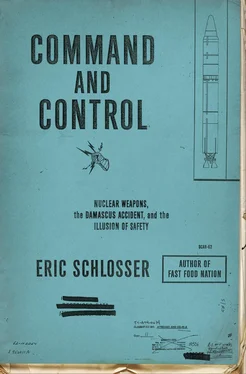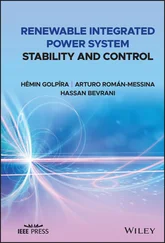The stage 2 oxidizer pressure cap was about two thirds of the way up the missile. In order to reach it, Powell and Plumb had to walk across a retractable steel platform that extended from the silo wall. The tall, hollow cylinder in which the Titan II stood was enclosed by another concrete cylinder with nine interior levels, housing equipment. Level 1 was near the top of the missile; level 9 about twenty feet beneath the missile. The steel work platforms folded down from the walls hydraulically. Each one had a stiff rubber edge to prevent the Titan II from getting scratched, while keeping the gap between the platform and the missile as narrow as possible.
The airmen entered the launch duct at level 2. Far above their heads was a concrete silo door. It was supposed to protect the missile from the wind and the rain and the effects of a nuclear weapon detonating nearby. The door weighed 740 tons. Far below the men, beneath the Titan II, a concrete flame deflector shaped like a W was installed to guide the hot gases downward at launch, then upward through exhaust vents and out of the silo. The missile stood on a thrust mount, a steel ring at level 7 that weighed about 26,000 pounds. The thrust mount was attached to the walls by large springs, so that the Titan II could ride out a nuclear attack, bounce instead of break, and then take off.
In addition to the W-53 warhead and a few hundred thousand pounds of propellants, many other things in the silo could detonate. Electroexplosive devices were used after ignition to free the missile from the thrust mount, separate stage 2 from stage 1, release the nose cone. The missile also housed numerous small rocket engines with flammable solid fuel to adjust the pitch and the roll of the warhead midflight. The Titan II launch complex had been carefully designed to minimize the risk of having so many flammables and explosives within it. Fire detectors, fire suppression systems, toxic vapor detectors, and decontamination showers were scattered throughout the nine levels of the silo. These safety devices were bolstered by strict safety rules.
Whenever a PTS team member put on a RFHCO, he had to be accompanied by someone else in a RFHCO, with two other people waiting as backup, ready to put on their suits. Every Category I task had to be performed according to a standardized checklist, which the team chief usually read aloud over the radio communications network. There was one way to do everything — and only one way. Technical Order 21M-LGM25C-2-12, Figure 2-18, told Powell and Plumb exactly what to do as they stood on the platform near the missile.
“Step four,” the PTS team chief said over the radio. “Remove airborne disconnect pressure cap.”
“Roger,” Powell replied.
“Caution. When complying with step four, do not exceed one hundred sixty foot-pounds of torque. Overtorquing may result in damage to the missile skin.”
“Roger.”
As Powell used a socket wrench to unscrew the pressure cap, the socket fell off. It struck the platform and bounced. Powell grabbed for it but missed.
Plumb watched the nine-pound socket slip through the narrow gap between the platform and the missile, fall about seventy feet, hit the thrust mount, and then ricochet off the Titan II. It seemed to happen in slow motion. A moment later, fuel sprayed from a hole in the missile like water from a garden hose.
“Oh man,” Plumb thought. “This is not good.”
Earlier that day, Second Lieutenant Allan D. Childers had gotten out of bed around five, showered, put on his uniform, kissed his wife good-bye, grabbed his overnight bag, and headed for the predeparture briefing at Little Rock Air Force Base. Childers was the deputy commander of a Titan II missile combat crew. At seven o’clock every morning, the crews about to pull an alert gathered in a large room at the headquarters of the 308th Strategic Missile Wing. The 308th operated eighteen Titan II launch complexes in Arkansas, each with a single missile and a four-man crew. The wing’s motto was Non sibi sed aliis — “Not for self but for others.” While senior officers and staff stood in the front of the briefing room, each combat crew sat at its own small table.
Childers took a seat with his crew. Captain Michael T. Mazzaro was the commander, a brilliant young officer from Massachusetts, about five foot eight, with thinning brown hair. Staff Sergeant Rodney L. Holder was the missile systems analyst technician, the one who made sure the missile was always ready to go. He looked a lot like Childers, tall and thin with fair hair and glasses. Staff Sergeant Ronald O. Fuller, handsome and baby faced, from Elmira, New York, was the missile facilities technician. His job focused on the workings of the launch site. Once or twice a week, the four of them began their days at one of these briefings and then spent the next twenty-four hours together underground, monitoring their missile; supervising maintenance at the site; constantly practicing, training, and awaiting the order to launch.
Childers hardly fit the stereotype of a warmongering Strategic Air Command (SAC) officer, eager to nuke the Soviets and bring on Armageddon. For about a year before joining the Air Force, he’d been a late-night radio DJ who played mainly acid rock, spent his days surfing, and had hair down to his shoulders. He wasn’t a hippie, but he also wasn’t harboring any lifelong ambition to become a spit-and-polish military officer. He’d spent most of his childhood on the Japanese island of Okinawa, where his father was an aircraft maintenance mechanic for the Air Force. The family home was a Quonset hut, a prefabricated steel building dating back to the Second World War. Although the accommodations were far from luxurious, growing up on that island during the 1960s was idyllic. Childers spent a lot of time lying on the beach and scuba diving. At Kadena Air Force Base the social divide between officers and enlisted men like his father was almost impossible to bridge. The two groups did not mix. But at the local high school nobody seemed to care about military ranks or racial distinctions. White, black, and Asian kids hung out together, and at various times Childers dated not only the daughter of a major but also the daughter of a colonel. Most of the students had a mother or a father in the armed services. The Vietnam War wasn’t a distant, abstract conflict debated in the classroom; it touched almost every household directly. Childers had two brothers and a sister, and they were all proud of their father. But none of them wanted anything to do with the military.
After graduating from high school in 1971, Childers went to the University of Arizona, hoping to become an engineer. He dropped out after a few semesters, returned to Okinawa, and found work as a disc jockey at a radio station on the island. He was nineteen, the youngest employee at the station, and they gave him the late-night shift. It was a dream job. From midnight until six in the morning, Childers played his favorite music — Led Zeppelin, Neil Young, Janis Joplin, Jimi Hendrix, Creedence Clearwater Revival. GIs would call the station and make requests. He loved dedicating songs on their behalf and reading messages on the air to their families and girlfriends. After work he’d sleep until noon, and then hit the beach.
The station in Okinawa went off the air in 1973, and Childers moved to Tampa, Florida, hoping to enroll in radio school. But he didn’t have enough money for tuition and, after a few months of looking for work, decided to join the Air Force. He expected to wind up in Vietnam, one way or another. Serving at an air base sounded a lot better than carrying a rifle and fighting in the jungle. When Childers enlisted, he filled out a form requesting an assignment with the Armed Forces Radio and Television Service. He thought the Air Force might provide his training to become a radio announcer. But he filled out the form incorrectly and got assigned to the newspaper at Norton Air Force Base in San Bernardino, California. He enjoyed the job and fell for Diane Brandeburg, a budget analyst who worked down the hall. In 1975 his commander persuaded him to become an officer, which would require a college degree. Through the Airman Scholarship and Commissioning Program, he attended Chaminade College of Honolulu, a good place to study and to surf. Diane was stationed at nearby Hickam Air Force Base, and they were married in 1977.
Читать дальше












